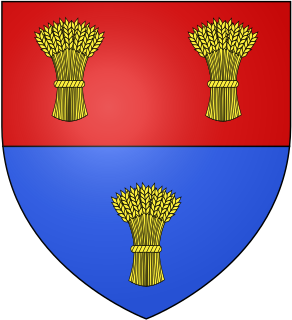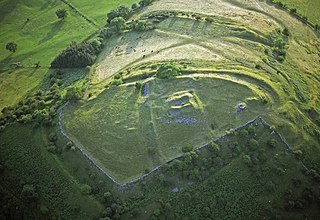
Hay-on-Wye, often abbreviated to just "Hay" is a small market town and community in the historic county of Brecknockshire (Breconshire) in Wales, currently administered as part of the unitary authority of Powys. With over twenty bookshops, it is often described as "the town of books", and is both the National Book Town of Wales and the site of the annual Hay Festival.

William de Braose, 3rd Lord of Bramber was a 12th-century Marcher lord who secured a foundation for the dominant position later held by the Braose family in the Welsh Marches. In addition to the family's English holdings in Sussex and Devon, William had inherited Radnor and Builth, in Wales, from his father Philip. By his marriage he increased the Braose Welsh holdings to include Brecon and Abergavenny.

William de Braose,, 4th Lord of Bramber, court favourite of King John of England, at the peak of his power, was also Lord of Gower, Abergavenny, Brecknock, Builth, Radnor, Kington, Limerick, Glamorgan, Skenfrith, Briouze in Normandy, Grosmont, and White Castle.
The title Baron Bergavenny was created several times in the Peerage of England and once in the Peerage of Great Britain, all but the first being baronies created by error. Abergavenny is a market town in South East Wales with a castle established by the Norman lord Hamelin de Balun c. 1087.

Miles FitzWalter of Gloucester, 1st Earl of Hereford was a great magnate based in the west of England. He was hereditary Constable of England and Sheriff of Gloucestershire.

Bernard de Neufmarché, also Bernard of Newmarket or Bernard of Newmarch was the first of the Norman conquerors of Wales. He was a minor Norman lord who rose to power in the Welsh Marches before successfully undertaking the invasion and conquest of the Kingdom of Brycheiniog between 1088 and 1095. Out of the ruins of the Welsh kingdom he created the Anglo-Norman lordship of Brecon.

Bronllys Castle is a motte and bailey fortress standing south of Bronllys, towards Talgarth in Powys, Wales. The original castle, constructed of wood, was founded in or soon after 1100 by Richard Fitz Pons, the owner of the nearby Herefordshire barony of Clifford, who was a supporter of Bernard of Neufmarché.

Castell Dinas is a hillfort and castle in southern Powys, Wales. At 450 m (SO179301) it has the highest castle in England and Wales. It is positioned to defend the Rhiangoll pass between Talgarth and Crickhowell.

Llanthony Secunda Priory was a house of Augustinian canons in the parish of Hempsted, Gloucestershire, England, situated about 1/2 a mile south-west of Gloucester Castle in the City of Gloucester. It was founded in 1136 by Miles de Gloucester, 1st Earl of Hereford, a great magnate based in the west of England and the Welsh Marches, hereditary Constable of England and Sheriff of Gloucestershire, as a secondary house and refuge for the canons of Llanthony Priory in the Vale of Ewyas, within his Lordship of Brecknock in what is now Monmouthshire, Wales. The surviving remains of the Priory were designated as Grade I listed in 1952 and the wider site is a scheduled ancient monument. In 2013 the Llanthony Secunda Priory Trust received funds for restoration work which was completed in August 2018 when it re-opened to the public.

Longtown is a linear village and parish in Herefordshire, England. The parish includes the village of Clodock and had a population in mid-2010 of 543, increasing to 620 at the 2011 Census.
Roger Fitzmiles, 2nd Earl of Hereford, was an English noble who played an active and influential part in the wars between Empress Matilda and King Stephen.

Glasbury, also known as Glasbury-on-Wye, is a village and community in Powys, Wales. The village lies at an important crossing point on the River Wye, connecting the historic counties of Brecknockshire and Radnorshire, and is located just outside the Brecon Beacons National Park, north of the Black Mountains. The village is split between the communities of Glasbury and Gwernyfed. The nearest town is Hay-on-Wye, some 4 miles (6 km) to the north east. The nearest city is Hereford in England, some 25 miles (40 km) to the east. Glasbury is a popular location for river fishing, canoeing and kayaking. The population of Glasbury community in Radnorshire was 994, in 1841 it was 838.
Walter of Hereford was a holder of the feudal title Baron Bergavenny or Lord Abergavenny in the Welsh Marches in the mid twelfth century.
William of Hereford, Baron Abergavenny was a holder of the feudal lordship of Abergavenny in the Welsh Marches in the mid twelfth century.
Bertha of Hereford, also known as Bertha de Pitres, was the daughter of Miles de Gloucester, 1st Earl of Hereford, and a wealthy heiress, Sibyl de Neufmarché. She was the wife of William de Braose, 3rd Lord of Bramber to whom she brought many castles and Lordships, such as Brecknock, and Abergavenny.
Sibyl de Neufmarché, Countess of Hereford, suo jure Lady of Brecknock, was a Cambro-Norman noblewoman, heiress to one of the most substantial fiefs in the Welsh Marches. The great-granddaughter of Gruffydd ap Llywelyn, king of Wales, Sibyl was also connected to the nobility of England and Normandy. Sibyl inherited the titles and lands of her father, Bernard de Neufmarché, Lord of Brecon, after her mother, Nest ferch Osbern, had declared her brother Mahel to have been illegitimate. Most of these estates passed to Sibyl's husband, Miles de Gloucester, 1st Earl of Hereford, as her dowry. Their marriage had been arranged personally by King Henry I of England in the spring of 1121. Sibyl, with her extensive lands, was central to the King's plans of consolidating Anglo-Norman power in south-east Wales by the merging of her estates with those of Miles, his loyal subject on whom he relied to implement Crown policy.

The House of Braose was a prominent family of Anglo-Norman nobles originating in Briouze, near Argentan, Orne, Normandy. Members of this family played a significant part in the Norman conquest of England and subsequent power struggles in England, Wales and Ireland in the 11th to 14th centuries.
Margaret of Hereford was an English noblewoman and the eldest daughter of Miles de Gloucester, 1st Earl of Hereford by his wife, the wealthy Cambro-Norman heiress Sibyl de Neufmarché. Margaret married Humphrey II de Bohun, by whom she had five children. Margaret held the office of Constable of England and as a widow, exercised lordship of Herefordshire until her own death. She was the benefactress of several religious institutions.
The Lordship of Brecknock was an Anglo-Norman marcher lordship located in southern central Wales.

Brecon Castle is a castle in the town of Brecon, Wales. It was built by the Norman Lord Bernard de Neufmarché in 1093, and was frequently assaulted by the Welsh in 13th and 15th centuries. The castle's ownership changed numerous times. It began falling into ruin when Henry VIII executed the last dukes of Buckingham, who at the time controlled the castle. It was renovated and made into a hotel in the early 19th century.











